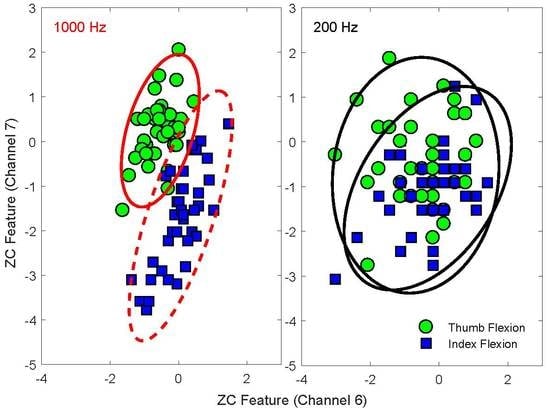Feature Extraction and Selection for Myoelectric Control Based on Wearable EMG Sensors
Abstract
:1. Introduction
2. Materials and Methods
2.1. EMG Datasets
2.2. Feature Extraction
2.2.1. The Signal Amplitude and Power Feature Group
2.2.2. The Nonlinear Complexity and Frequency Information Feature Group
2.2.3. The Time-Series Modelling Feature Group
2.2.4. The Unique Feature Group
2.2.5. Multi-Feature Sets
2.3. Feature Evaluation and Selection
3. Results
4. Discussion
Limitations and Future Studies
5. Conclusions
Author Contributions
Funding
Conflicts of Interest
References
- Phinyomark, A.; Phukpattaranont, P.; Limsakul, C. A review of control methods for electric power wheelchairs based on electromyography signals with special emphasis on pattern recognition. IETE Tech. Rev. 2011, 28, 316–326. [Google Scholar] [CrossRef]
- Oskoei, M.A.; Hu, H. Myoelectric control systems—A survey. Biomed. Signal Process. Control 2007, 2, 275–294. [Google Scholar] [CrossRef]
- Saponas, T.S.; Tan, D.S.; Morris, D.; Balakrishnan, R.; Turner, J.; Landay, J.A. Enabling always-available input with muscle-computer interfaces. In Proceedings of the 22nd Annual ACM Symposium on User Interface Software and Technology, Victoria, BC, Canada, 4–7 October 2009; ACM: New York, NY, USA, 2009; pp. 167–176. [Google Scholar]
- Phinyomark, A.; Quaine, F.; Laurillau, Y. The Relationship between Anthropometric Variables and Features of Electromyography Signal for Human—Computer Interface. In Applications, Challenges, and Advancements in Electromyography Signal Processing; Naik, G.R., Ed.; IGI Global: Hershey, PA, USA, 2014; Chapter 15; pp. 321–353. [Google Scholar]
- Tabor, A.; Bateman, S.; Scheme, E. Game-Based Myoelectric Training. In Proceedings of the ACM SIGCHI Annual Symposium on Computer-Human Interaction in Play Companion, Austin, TX, USA, 16–19 October 2016; ACM: New York, NY, USA, 2016; pp. 299–306. [Google Scholar]
- Tabor, A.; Bateman, S.; Scheme, E.; Flatla, D.R.; Gerling, K. Designing Game-Based Myoelectric Prosthesis Training. In Proceedings of the ACM CHI Conference on Human Factors in Computing Systems, Denver, CO, USA, 6–11 May 2017; ACM: New York, NY, USA, 2017; pp. 1352–1363. [Google Scholar] [CrossRef]
- Raina, A.; Lakshmi, T.G.; Murthy, S. CoMBaT: Wearable Technology Based Training System for Novice Badminton Players. In Proceedings of the IEEE 17th International Conference on Advanced Learning Technologies, Timisoara, Romania, 3–7 July 2017; pp. 153–157. [Google Scholar]
- Abreu, J.G.; Teixeira, J.M.; Figueiredo, L.S.; Teichrieb, V. Evaluating Sign Language Recognition Using the Myo Armband. In Proceedings of the XVIII Symposium on Virtual and Augmented Reality, Gramado, Brazil, 21–24 June 2016; pp. 64–70. [Google Scholar]
- Zhang, R.; Zhang, N.; Du, C.; Lou, W.; Hou, Y.T.; Kawamoto, Y. AugAuth: Shoulder-surfing resistant authentication for augmented reality. In Proceedings of the IEEE International Conference on Communications, Paris, France, 21–25 May 2017; pp. 1–6. [Google Scholar]
- Hargrove, L.; Scheme, E.; Englehart, K. Myoelectric Prostheses and Targeted Reinnervation. In Introduction to Neural Engineering for Motor Rehabilitation; John Wiley & Sons, Inc.: Hoboken, NJ, USA, 2013; pp. 291–310. [Google Scholar] [CrossRef]
- Scheme, E.; Englehart, K. Electromyogram pattern recognition for control of powered upper-limb prostheses: State of the art and challenges for clinical use. J. Rehabil. Res. Dev. 2011, 48, 643–660. [Google Scholar] [CrossRef] [PubMed]
- Phinyomark, A.; Phukpattaranont, P.; Limsakul, C. Feature reduction and selection for EMG signal classification. Expert Syst. Appl. 2012, 39, 7420–7431. [Google Scholar] [CrossRef]
- Boostani, R.; Moradi, M.H. Evaluation of the forearm EMG signal features for the control of a prosthetic hand. Physiol. Meas. 2003, 24, 309. [Google Scholar] [CrossRef] [PubMed]
- Zardoshti-Kermani, M.; Wheeler, B.C.; Badie, K.; Hashemi, R.M. EMG feature evaluation for movement control of upper extremity prostheses. IEEE Trans. Rehabil. Eng. 1995, 3, 324–333. [Google Scholar] [CrossRef]
- Chen, H.; Zhang, Y.; Zhang, Z.; Fang, Y.; Liu, H.; Yao, C. Exploring the relation between EMG sampling frequency and hand motion recognition accuracy. In Proceedings of the IEEE International Conference on Systems, Man, and Cybernetics (SMC), Banff, AB, Canada, 5–8 October 2017; pp. 1139–1144. [Google Scholar] [CrossRef]
- Li, G.; Li, Y.; Yu, L.; Geng, Y. Conditioning and Sampling Issues of EMG Signals in Motion Recognition of Multifunctional Myoelectric Prostheses. Ann. Biomed. Eng. 2011, 39, 1779–1787. [Google Scholar] [CrossRef] [PubMed]
- Li, Y.; Chen, X.; Zhang, X.; Zhou, P. Several practical issues toward implementing myoelectric pattern recognition for stroke rehabilitation. Med. Eng. Phys. 2014, 36, 754–760. [Google Scholar] [CrossRef] [PubMed]
- Wilson, A.W.; Losier, Y.G.; Parker, P.A.; Lovely, D.F. A bus-based smart myoelectric electrode/ amplifier-system requirements. IEEE Trans. Instrum. Meas. 2011, 60, 3290–3299. [Google Scholar] [CrossRef]
- Arief, Z.; Sulistijono, I.A.; Ardiansyah, R.A. Comparison of five time series EMG features extractions using Myo Armband. In Proceedings of the International Electronics Symposium, Surabaya, Indonesia, 29–30 September 2015; pp. 11–14. [Google Scholar]
- Sueaseenak, D.; Khawdee, C.; Pakornsirikul, N.; Sukjamsri, C. A performance of modern gesture control device with application in pattern classification. In Proceedings of the 3rd International Conference on Control, Automation and Robotics, Nagoya, Japan, 24–26 April 2017; pp. 428–431. [Google Scholar]
- Amirabdollahian, F.; Walters, M.L. Application of support vector machines in detecting hand grasp gestures using a commercially off the shelf wireless myoelectric armband. In Proceedings of the International Conference on Rehabilitation Robotics, London, UK, 17–20 July 2017; pp. 111–115. [Google Scholar]
- Mendez, I.; Hansen, B.W.; Grabow, C.M.; Smedegaard, E.J.L.; Skogberg, N.B.; Uth, X.J.; Bruhn, A.; Geng, B.; Kamavuako, E.N. Evaluation of the Myo armband for the classification of hand motions. In Proceedings of the International Conference on Rehabilitation Robotics, London, UK, 17–20 July 2017; pp. 1211–1214. [Google Scholar]
- Phinyomark, A.; Phukpattaranont, P.; Limsakul, C. Investigating Long-term Effects of Feature Extraction Methods for Continuous EMG Pattern Classification. Fluct. Noise Lett. 2012, 11, 1250028. [Google Scholar] [CrossRef]
- Phinyomark, A.; Quaine, F.; Charbonnier, S.; Serviere, C.; Tarpin-Bernard, F.; Laurillau, Y. EMG feature evaluation for improving myoelectric pattern recognition robustness. Expert Syst. Appl. 2013, 40, 4832–4840. [Google Scholar] [CrossRef]
- Radmand, A.; Scheme, E.; Englehart, K. On the Suitability of Integrating Accelerometry Data with Electromyography Signals for Resolving the Effect of Changes in Limb Position during Dynamic Limb Movement. J. Prosthet. Orthot. 2014, 26, 185–193. [Google Scholar] [CrossRef]
- Khushaba, R.N.; Takruri, M.; Miro, J.V.; Kodagoda, S. Towards limb position invariant myoelectric pattern recognition using time-dependent spectral features. Neural Netw. 2014, 55, 42–58. [Google Scholar] [CrossRef] [PubMed]
- Khushaba, R.N.; Al-Timemy, A.; Kodagoda, S.; Nazarpour, K. Combined influence of forearm orientation and muscular contraction on EMG pattern recognition. Expert Syst. Appl. 2016, 61, 154–161. [Google Scholar] [CrossRef]
- Al-Timemy, A.H.; Khushaba, R.N.; Bugmann, G.; Escudero, J. Improving the Performance Against Force Variation of EMG Controlled Multifunctional Upper-Limb Prostheses for Transradial Amputees. IEEE Trans. Neural Syst. Rehabil. Eng. 2016, 24, 650–661. [Google Scholar] [CrossRef] [PubMed]
- Thongpanja, S.; Phinyomark, A.; Quaine, F.; Laurillau, Y.; Limsakul, C.; Phukpattaranont, P. Probability Density Functions of Stationary Surface EMG Signals in Noisy Environments. IEEE Trans. Instrum. Meas. 2016, 65, 1547–1557. [Google Scholar] [CrossRef]
- Hosking, J.R.M. L-Moments: Analysis and Estimation of Distributions Using Linear Combinations of Order Statistics. J. R. Stat. Soc. Ser. B (Methodol.) 1990, 52, 105–124. [Google Scholar]
- Pizzolato, S.; Tagliapietra, L.; Cognolato, M.; Reggiani, M.; Müller, H.; Atzori, M. Comparison of six electromyography acquisition setups on hand movement classification tasks. PLoS ONE 2017, 12, e0186132. [Google Scholar] [CrossRef] [PubMed]
- Phinyomark, A.; Khushaba, R.N.; Ibáñez-Marcelo, E.; Patania, A.; Scheme, E.; Petri, G. Navigating features: A topologically informed chart of electromyographic features space. J. R. Soc. Interface 2017, 14. [Google Scholar] [CrossRef] [PubMed]
- Kamavuako, E.N.; Scheme, E.J.; Englehart, K.B. Determination of optimum threshold values for EMG time domain features; A multi-dataset investigation. J. Neural Eng. 2016, 13, 046011. [Google Scholar] [CrossRef] [PubMed]
- Atzori, M.; Gijsberts, A.; Castellini, C.; Caputo, B.; Hager, A.G.M.; Elsig, S.; Giatsidis, G.; Bassetto, F.; Müller, H. Electromyography data for non-invasive naturally-controlled robotic hand prostheses. Sci. Data 2014, 1, 140053. [Google Scholar] [CrossRef] [PubMed] [Green Version]
- Phinyomark, A.; Limsakul, C.; Phukpattaranont, P. EMG Feature Extraction for Tolerance of 50 Hz Interference. In Proceedings of the 4th PSU-UNS International Conference on Engineering Technologies, Novi Sad, Serbia, 28–30 April 2009; pp. 289–293. [Google Scholar]
- Phinyomark, A.; Limsakul, C.; Phukpattaranont, P. EMG Feature Extraction for Tolerance of White Gaussian Noise. In Proceedings of the International Workshop and Symposium Science Technology, Nong Khai, Thailand, 15–16 December 2008; pp. 178–183. [Google Scholar]
- Englehart, K.; Hudgins, B. A robust, real-time control scheme for multifunction myoelectric control. IEEE Trans. Biomed. Eng. 2003, 50, 848–854. [Google Scholar] [CrossRef] [PubMed]
- Phinyomark, A.; Quaine, F.; Charbonnier, S.; Serviere, C.; Tarpin-Bernard, F.; Laurillau, Y. Feature extraction of the first difference of EMG time series for EMG pattern recognition. Comput. Methods Programs Biomed. 2014, 117, 247–256. [Google Scholar] [CrossRef] [PubMed]
- Samuel, O.W.; Zhou, H.; Li, X.; Wang, H.; Zhang, H.; Sangaiah, A.K.; Li, G. Pattern recognition of electromyography signals based on novel time domain features for amputees’ limb motion classification. Comput. Electr. Eng. 2017. [Google Scholar] [CrossRef]
- Phinyomark, A.; Phukpattaranont, P.; Limsakul, C. Fractal analysis features for weak and single-channel upper-limb EMG signals. Expert Syst. Appl. 2012, 39, 11156–11163. [Google Scholar] [CrossRef]
- Liu, Y.H.; Huang, H.P.; Weng, C.H. Recognition of Electromyographic Signals Using Cascaded Kernel Learning Machine. IEEE/ASME Trans. Mechatron. 2007, 12, 253–264. [Google Scholar] [CrossRef]
- Huang, Y.; Englehart, K.B.; Hudgins, B.; Chan, A.D.C. A Gaussian mixture model based classification scheme for myoelectric control of powered upper limb prostheses. IEEE Trans. Biomed. Eng. 2005, 52, 1801–1811. [Google Scholar] [CrossRef] [PubMed]
- Tkach, D.; Huang, H.; Kuiken, T.A. Study of stability of time-domain features for electromyographic pattern recognition. J. NeuroEng. Rehabil. 2010, 7, 21. [Google Scholar] [CrossRef] [PubMed]
- Hudgins, B.; Parker, P.; Scott, R.N. A new strategy for multifunction myoelectric control. IEEE Trans. Biomed. Eng. 1993, 40, 82–94. [Google Scholar] [CrossRef] [PubMed]
- Chang, C.C.; Lin, C.J. LIBSVM: A Library for Support Vector Machines. ACM Trans. Intell. Syst. Technol. 2011, 2, 27:1–27:27. [Google Scholar] [CrossRef]
- Oskoei, M.A.; Hu, H. Support Vector Machine-Based Classification Scheme for Myoelectric Control Applied to Upper Limb. IEEE Trans. Biomed. Eng. 2008, 55, 1956–1965. [Google Scholar] [CrossRef] [PubMed]
- León, M.; Gutiérrez, J.M.; Leija, L.; Muñoz, R. EMG pattern recognition using support vector machines classifier for myoelectric control purposes. In Proceedings of the 2011 Pan American Health Care Exchanges, Rio de Janeiro, Brazil, 28 March–1 April 2011; pp. 175–178. [Google Scholar] [CrossRef]
- Phinyomark, A.; Scheme, E. A Feature Extraction Issue for Myoelectric Control Based on Wearable EMG Sensors. In Proceedings of the 2018 IEEE Sensors Applications Symposium (SAS), Seoul, Korea, 12–14 March 2018; pp. 1–6. [Google Scholar] [CrossRef]
- Bunderson, N.E.; Kuiken, T.A. Quantification of feature space changes with experience during electromyogram pattern recognition control. IEEE Trans. Neural Syst. Rehabil. Eng. 2012, 20, 239–246. [Google Scholar] [CrossRef] [PubMed]
- Cohen, J. Statistical Power Analysis for the Behavioral Sciences; Academic Press: New York, NY, USA, 1976. [Google Scholar]
- Sawilowsky, S.S. New Effect Size Rules of Thumb. J. Mod. Appl. Stat. Methods 2009, 8, 597–599. [Google Scholar] [CrossRef]
- Nazarpour, K.; Sharafat, A.R.; Firoozabadi, S.M.P. Application of Higher Order Statistics to Surface Electromyogram Signal Classification. IEEE Trans. Biomed. Eng. 2007, 54, 1762–1769. [Google Scholar] [CrossRef] [PubMed]
- Huang, H.; Zhou, P.; Li, G.; Kuiken, T.A. An Analysis of EMG Electrode Configuration for Targeted Muscle Reinnervation Based Neural Machine Interface. IEEE Trans. Neural Syst. Rehabil. Eng. 2008, 16, 37–45. [Google Scholar] [CrossRef] [PubMed]
- Yentes, J.M.; Hunt, N.; Schmid, K.K.; Kaipust, J.P.; McGrath, D.; Stergiou, N. The appropriate use of approximate entropy and sample entropy with short data sets. Ann. Biomed. Eng. 2013, 41, 349–365. [Google Scholar] [CrossRef] [PubMed]
- Scheme, E.; Biron, K.; Englehart, K. Improving myoelectric pattern recognition positional robustness using advanced training protocols. In Proceedings of the Annual International Conference of the IEEE Engineering in Medicine and Biology Society, Boston, MA, USA, 30 August–3 September 2011; pp. 4828–4831. [Google Scholar] [CrossRef]
- Irwin, Z.T.; Thompson, D.E.; Schroeder, K.E.; Tat, D.M.; Hassani, A.; Bullard, A.J.; Woo, S.L.; Urbanchek, M.G.; Sachs, A.J.; Cederna, P.S.; et al. Enabling Low-Power, Multi-Modal Neural Interfaces Through a Common, Low-Bandwidth Feature Space. IEEE Trans. Neural Syst. Rehabil. Eng. 2016, 24, 521–531. [Google Scholar] [CrossRef] [PubMed]

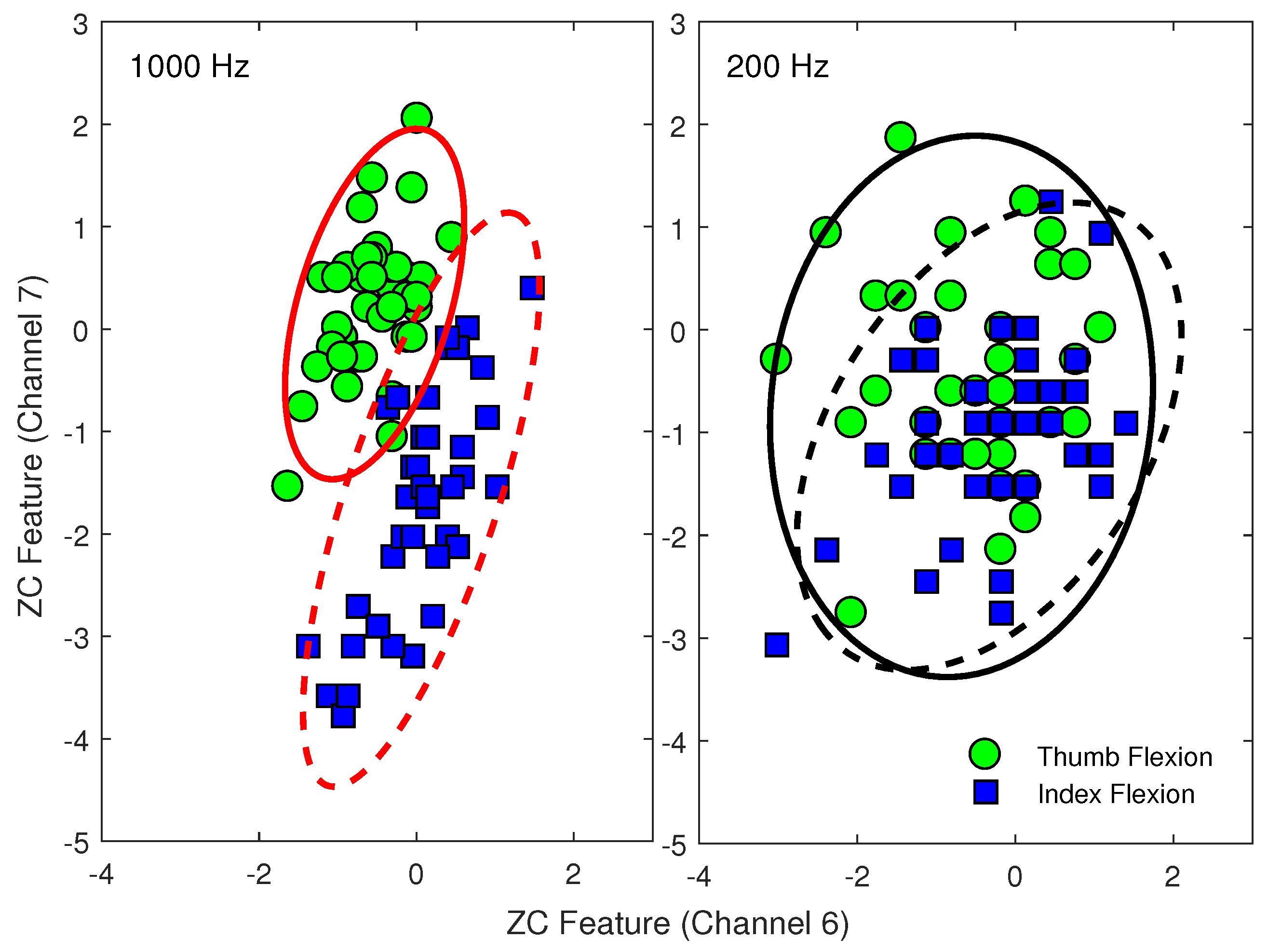
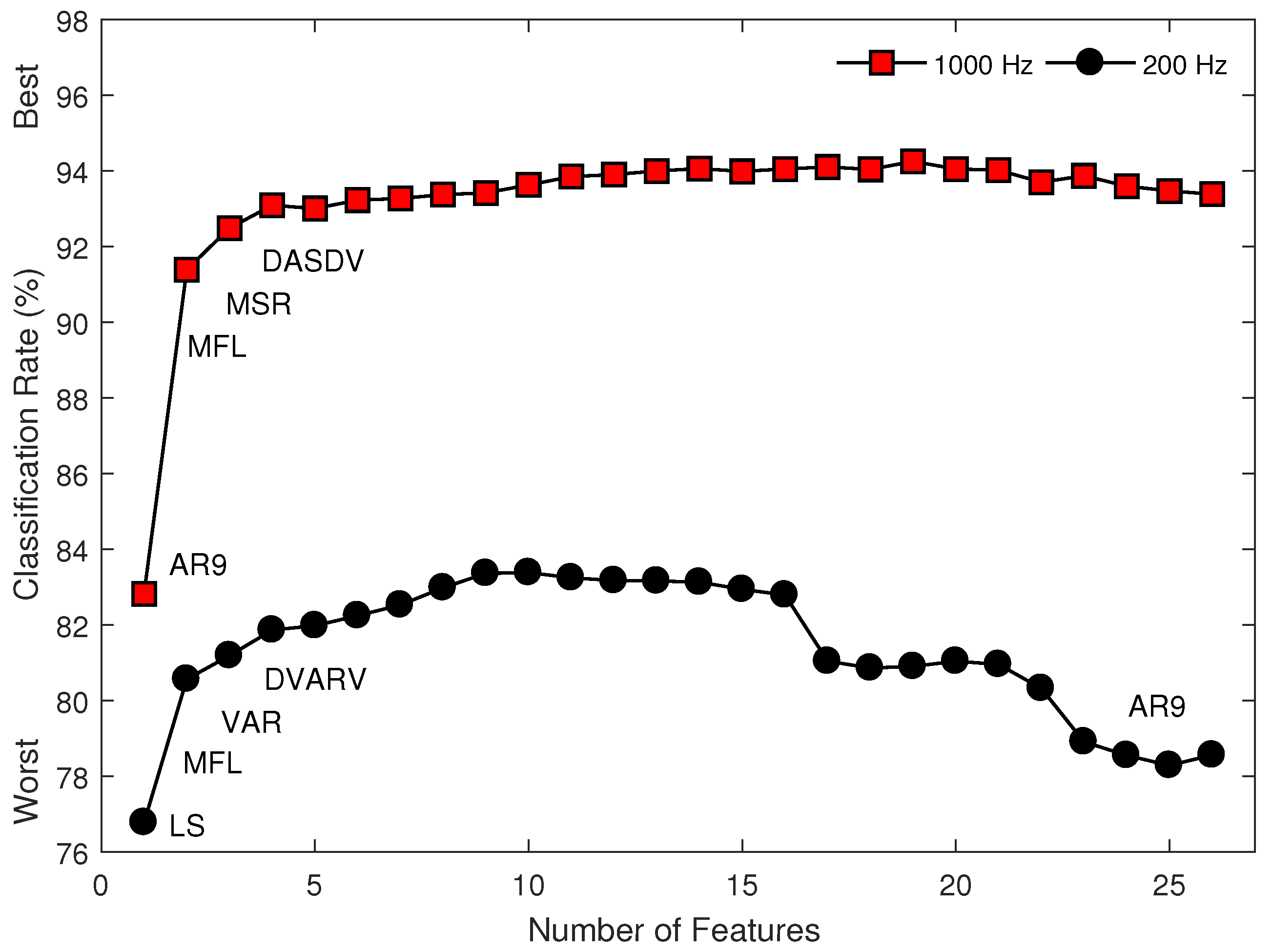

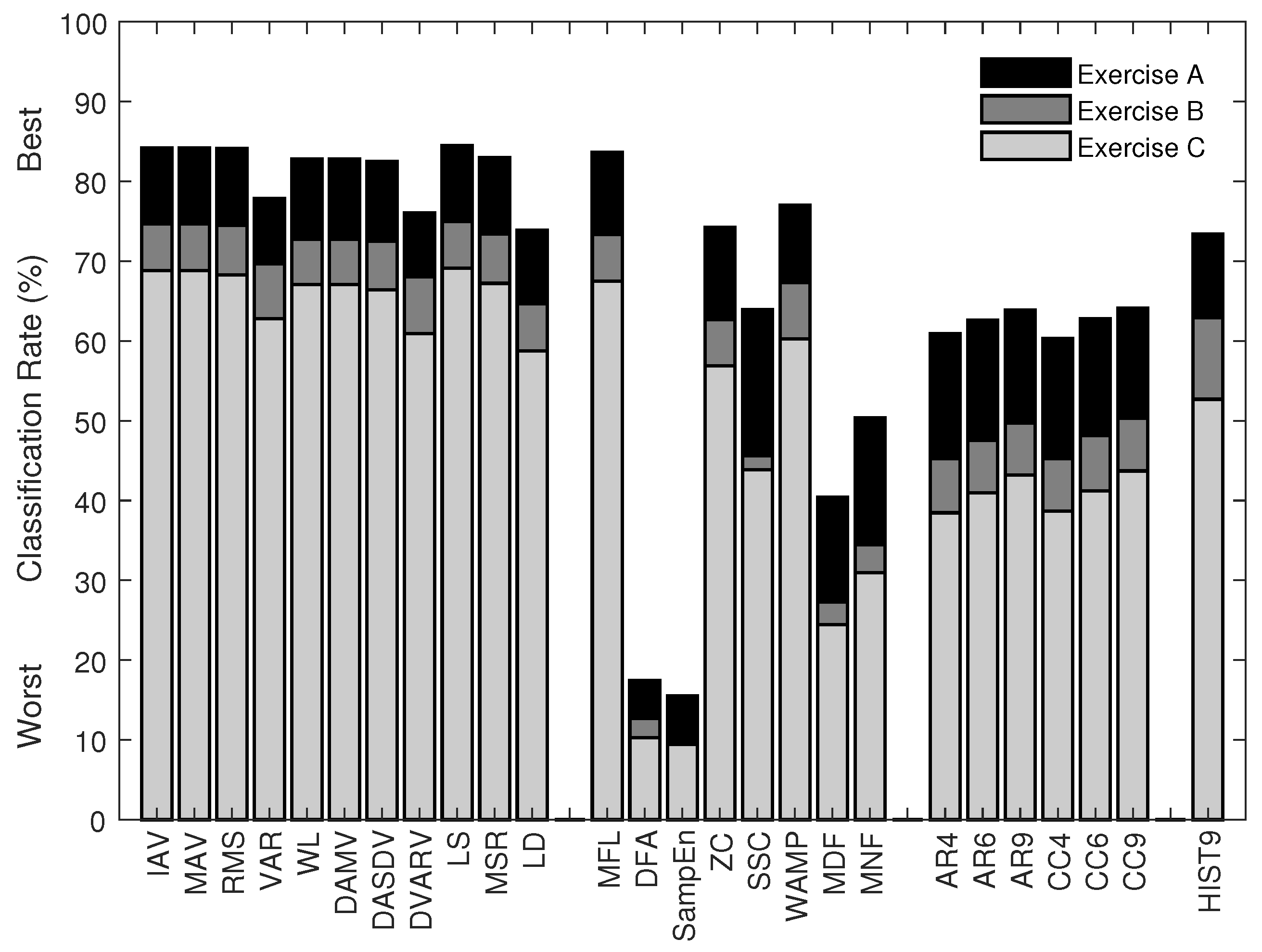
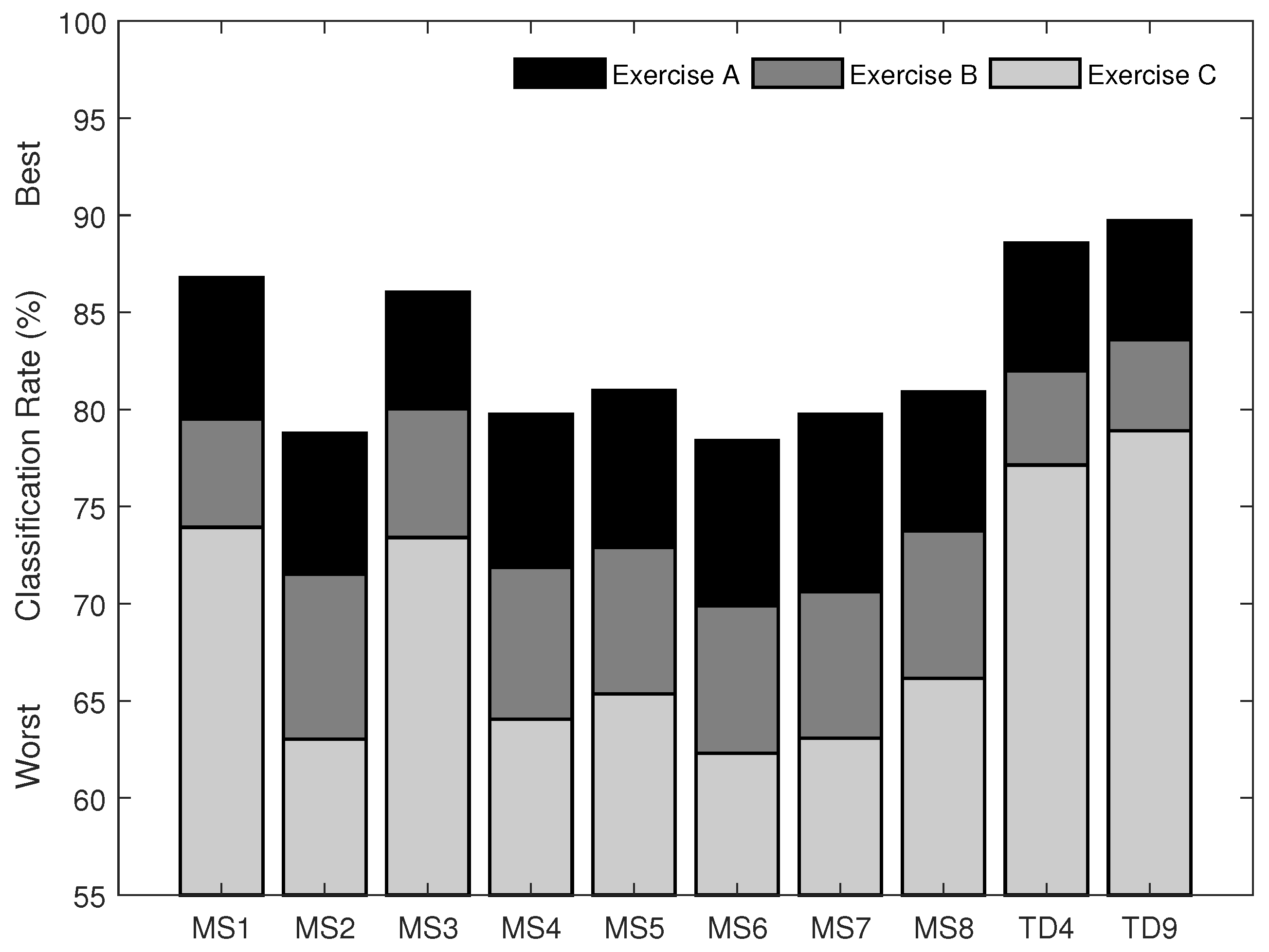
| Dataset 1 [26] | Dataset 2 [27] | Dataset 3 [28] | Dataset 4 [31] | |
|---|---|---|---|---|
| Practical Issue(s) | Limb position (5 positions) | Forearm orientation (3 orientations), Contraction intensity (3 levels) | Amputation, Contraction intensity (3 levels) | Wearable sensors (Myo armband) |
| Number of Subjects | 11 (able-bodied) | 10 (able-bodied) | 9 (amputee) | 10 (able-bodied) |
| Number of Movements | 7 | 6 | 6 | 52 (12 + 17 + 23) |
| Number of Repetitions | 6 | 3 | 5–11 | 6 |
| Total Number of Trials | 2310 | 1620 | 1077 | 3120 |
| Time for Each Trial | 5 s | 5 s | 8–12 s | 5 s |
| Original Sampling Rate | 4000 Hz | 4000 Hz | 2000 Hz | 200 Hz |
| Resolution | 12-bit | 12-bit | 16-bit | 8-bit |
| Number of Electrodes | 7 | 6 | 8 | 16 |
| Multi-Feature Set | Able-Bodied Subjects | Amputee Subjects | Mean | ||||||||||||
|---|---|---|---|---|---|---|---|---|---|---|---|---|---|---|---|
| Limb Position | Forearm Orientation | Contraction Intensity | Contraction Intensity | ||||||||||||
| 1000 | 200 | d | 1000 | 200 | d | 1000 | 200 | d | 1000 | 200 | d | 1000 | 200 | d | |
| MS1 (TD) | 98.3 | 93.9 | 1.7 * | 98.2 | 92.7 | 1.3 * | 99.1 | 96.8 | 1.0 * | 89.8 | 78.4 | 1.6 * | 96.3 | 90.4 | 1.4 |
| MS2 | 98.8 | 93.3 | 2.0 * | 98.7 | 92.0 | 1.5 * | 99.3 | 96.2 | 1.2 * | 91.9 | 78.7 | 2.1 * | 97.2 | 90.1 | 1.7 |
| MS3 | 99.1 | 94.1 | 2.1 * | 99.1 | 92.4 | 1.6 * | 99.5 | 96.7 | 1.2 * | 93.5 | 79.9 | 2.2 * | 97.8 | 90.8 | 1.8 |
| MS4 | 97.1 | 84.6 | 3.5 * | 96.9 | 84.8 | 2.2 * | 97.7 | 88.6 | 1.8 * | 88.5 | 72.1 | 2.2 * | 95.0 | 82.5 | 2.4 |
| MS5 | 98.9 | 93.4 | 2.1 * | 98.7 | 91.6 | 1.6 * | 99.4 | 95.6 | 1.3 * | 92.7 | 77.6 | 2.4 * | 97.4 | 89.6 | 1.8 |
| MS6 | 98.6 | 92.6 | 2.1 * | 98.1 | 89.6 | 1.9 * | 99.0 | 94.0 | 1.5 * | 91.9 | 76.1 | 2.6 * | 96.9 | 88.1 | 2.0 |
| MS7 | 97.1 | 93.8 | 1.2 * | 97.6 | 92.8 | 1.2 * | 98.6 | 96.2 | 0.9 * | 85.9 | 78.8 | 0.9 * | 94.8 | 90.4 | 1.0 |
| MS8 | 99.1 | 93.7 | 2.1 * | 99.0 | 92.2 | 1.6 * | 99.6 | 96.4 | 1.4 * | 93.1 | 79.6 | 2.1 * | 97.7 | 90.5 | 1.8 |
| Feature Set | Able-Bodied Subjects | Amputee Subjects | Mean | ||||||||||||
|---|---|---|---|---|---|---|---|---|---|---|---|---|---|---|---|
| Limb Position | Forearm Orientation | Contraction Intensity | Contraction Intensity | ||||||||||||
| 1000 | 200 | d | 1000 | 200 | d | 1000 | 200 | d | 1000 | 200 | d | 1000 | 200 | d | |
| IAV | 95.2 | 92.6 | 0.7 * | 94.9 | 91.4 | 0.6 * | 98.4 | 96.3 | 0.7 * | 80.8 | 76.4 | 0.6 * | 92.3 | 89.2 | 0.7 |
| MAV | 95.2 | 92.6 | 0.7 * | 94.9 | 91.4 | 0.6 * | 98.4 | 96.3 | 0.7 * | 80.8 | 76.4 | 0.6 * | 92.3 | 89.2 | 0.7 |
| RMS | 95.2 | 92.5 | 0.7 * | 94.8 | 91.1 | 0.6 * | 98.2 | 96.2 | 0.7 * | 80.7 | 76.8 | 0.5 * | 92.2 | 89.2 | 0.6 |
| VAR | 93.1 | 89.2 | 0.7 * | 90.3 | 86.7 | 0.5 * | 94.7 | 92.9 | 0.3 * | 75.5 | 70.7 | 0.5 * | 88.4 | 84.9 | 0.5 |
| WL | 95.9 | 92.7 | 0.9 * | 96.2 | 91.1 | 0.9 * | 98.4 | 96.5 | 0.7 * | 80.4 | 75.2 | 0.6 * | 92.7 | 88.9 | 0.8 |
| DAMV | 95.9 | 92.7 | 0.9 * | 96.2 | 91.1 | 0.9 * | 98.4 | 96.5 | 0.7 * | 80.4 | 75.2 | 0.6 * | 92.7 | 88.9 | 0.8 |
| DASDV | 95.9 | 92.7 | 0.9 * | 95.9 | 91.1 | 0.9 * | 98.3 | 96.2 | 0.7 * | 79.8 | 75.5 | 0.5 * | 92.5 | 88.9 | 0.8 |
| DVARV | 93.6 | 89.5 | 0.7 * | 90.7 | 86.5 | 0.6 * | 94.6 | 92.6 | 0.4 * | 75.5 | 70.0 | 0.6 * | 88.6 | 84.7 | 0.6 |
| LS | 95.3 | 92.6 | 0.7 * | 95.0 | 91.5 | 0.6 * | 98.4 | 96.4 | 0.7 * | 81.1 | 77.0 | 0.6 * | 92.4 | 89.4 | 0.6 |
| MSR | 95.4 | 92.3 | 0.9 * | 95.5 | 91.7 | 0.7 * | 98.4 | 96.4 | 0.7 * | 80.7 | 75.1 | 0.7 * | 92.5 | 88.9 | 0.7 |
| LD | 94.4 | 90.2 | 1.0 * | 94.0 | 89.7 | 0.7 * | 97.8 | 94.7 | 0.9 * | 76.9 | 69.6 | 0.9 * | 90.7 | 86.1 | 0.9 |
| MFL | 96.5 | 93.1 | 1.1 * | 97.2 | 92.1 | 1.0 * | 98.9 | 96.8 | 0.8 * | 81.2 | 76.1 | 0.6 * | 93.4 | 89.5 | 0.9 |
| DFA | 72.0 | 32.4 | 9.5 * | 63.3 | 33.8 | 4.6 * | 69.6 | 36.2 | 3.2 * | 58.4 | 27.9 | 4.6 * | 65.8 | 32.6 | 5.5 |
| SampEn | 72.9 | 16.7 | 12.0 * | 66.4 | 18.3 | 7.9 * | 70.1 | 19.3 | 7.3 * | 56.9 | 17.9 | 5.4 * | 66.6 | 18.1 | 8.1 |
| ZC | 66.2 | 54.3 | 2.1 * | 58.0 | 54.1 | 0.5 | 68.0 | 59.7 | 0.8 * | 53.6 | 34.5 | 2.6 * | 61.4 | 50.6 | 1.5 |
| SSC | 66.2 | 38.4 | 5.4 * | 60.2 | 39.6 | 3.1 * | 64.1 | 43.6 | 2.7 * | 53.6 | 31.0 | 2.7 * | 61.0 | 38.1 | 3.5 |
| WAMP | 92.0 | 79.0 | 2.7 * | 91.9 | 77.7 | 1.9 * | 96.1 | 81.5 | 2.6 * | 61.5 | 49.2 | 1.2 * | 85.4 | 71.8 | 2.1 |
| MDF | 72.4 | 44.0 | 5.5 * | 64.2 | 45.5 | 2.6 * | 72.9 | 49.9 | 2.1 * | 56.2 | 35.0 | 3.2 * | 66.4 | 43.6 | 3.4 |
| MNF | 77.5 | 50.2 | 5.2 * | 71.1 | 51.1 | 2.8 * | 77.4 | 55.9 | 2.0 * | 65.3 | 38.7 | 3.8 * | 72.8 | 48.9 | 3.4 |
| AR4 | 93.6 | 54.4 | 11.2 * | 92.2 | 54.1 | 8.2 * | 94.2 | 58.9 | 6.9 * | 81.8 | 45.3 | 5.7 * | 90.5 | 53.2 | 8.0 |
| AR6 | 94.3 | 54.5 | 11.7 * | 93.2 | 54.0 | 8.4 * | 95.1 | 58.4 | 8.2 * | 83.1 | 45.4 | 6.1 * | 91.4 | 53.1 | 8.6 |
| AR9 | 94.5 | 54.8 | 10.8 * | 93.2 | 54.0 | 8.7 * | 95.5 | 58.6 | 9.3 * | 83.9 | 45.2 | 6.1 * | 91.8 | 53.2 | 8.8 |
| CC4 | 93.4 | 54.3 | 10.7 * | 91.2 | 54.0 | 7.4 * | 93.2 | 58.6 | 6.1 * | 81.3 | 45.0 | 5.8 * | 89.8 | 53.0 | 7.5 |
| CC6 | 94.0 | 54.6 | 10.7 * | 91.6 | 54.0 | 7.4 * | 94.1 | 58.2 | 6.1 * | 82.3 | 45.4 | 5.8 * | 90.5 | 53.0 | 7.5 |
| CC9 | 94.1 | 54.8 | 10.4 * | 91.5 | 53.4 | 8.0 * | 94.3 | 57.5 | 8.4 * | 83.4 | 44.8 | 6.4 * | 90.8 | 52.6 | 8.3 |
| HIST9 | 84.9 | 80.2 | 0.8 * | 84.2 | 81.3 | 0.4 | 88.7 | 85.8 | 0.3 | 72.1 | 68.0 | 0.5 * | 82.5 | 78.8 | 0.5 |
© 2018 by the authors. Licensee MDPI, Basel, Switzerland. This article is an open access article distributed under the terms and conditions of the Creative Commons Attribution (CC BY) license (http://creativecommons.org/licenses/by/4.0/).
Share and Cite
Phinyomark, A.; N. Khushaba, R.; Scheme, E. Feature Extraction and Selection for Myoelectric Control Based on Wearable EMG Sensors. Sensors 2018, 18, 1615. https://doi.org/10.3390/s18051615
Phinyomark A, N. Khushaba R, Scheme E. Feature Extraction and Selection for Myoelectric Control Based on Wearable EMG Sensors. Sensors. 2018; 18(5):1615. https://doi.org/10.3390/s18051615
Chicago/Turabian StylePhinyomark, Angkoon, Rami N. Khushaba, and Erik Scheme. 2018. "Feature Extraction and Selection for Myoelectric Control Based on Wearable EMG Sensors" Sensors 18, no. 5: 1615. https://doi.org/10.3390/s18051615




